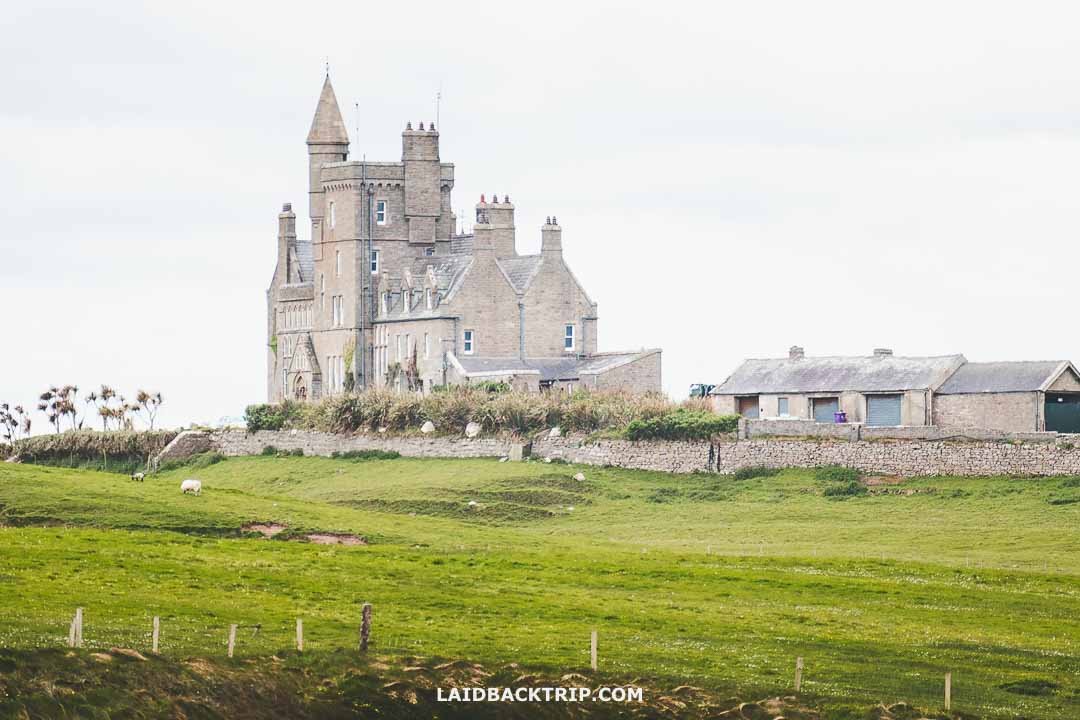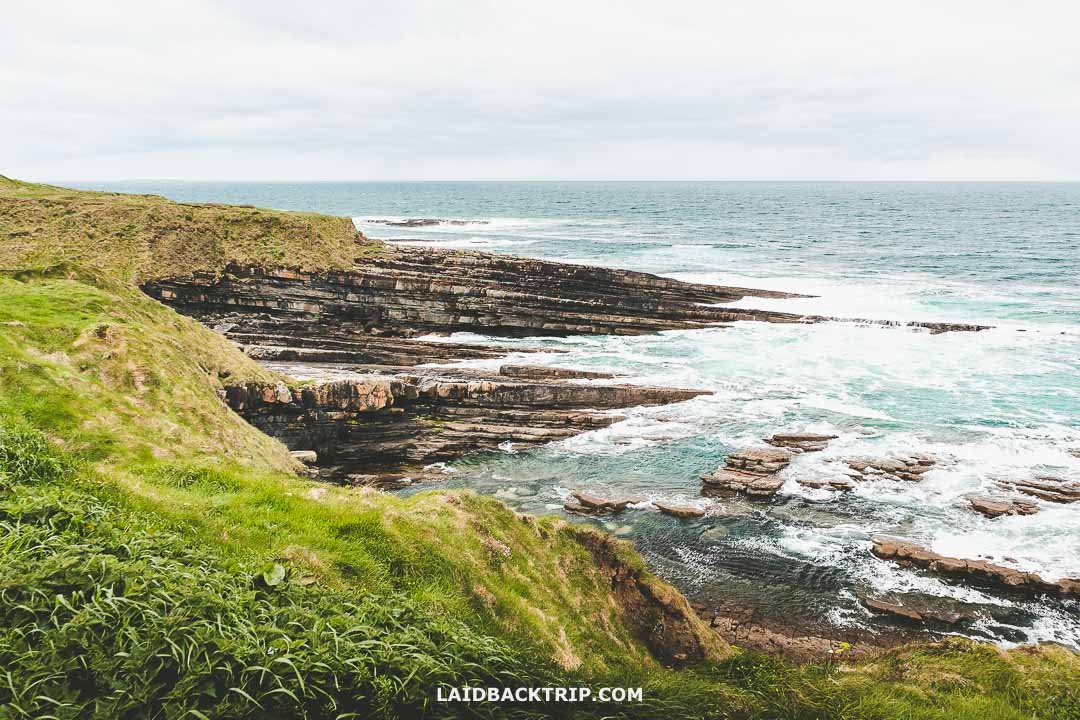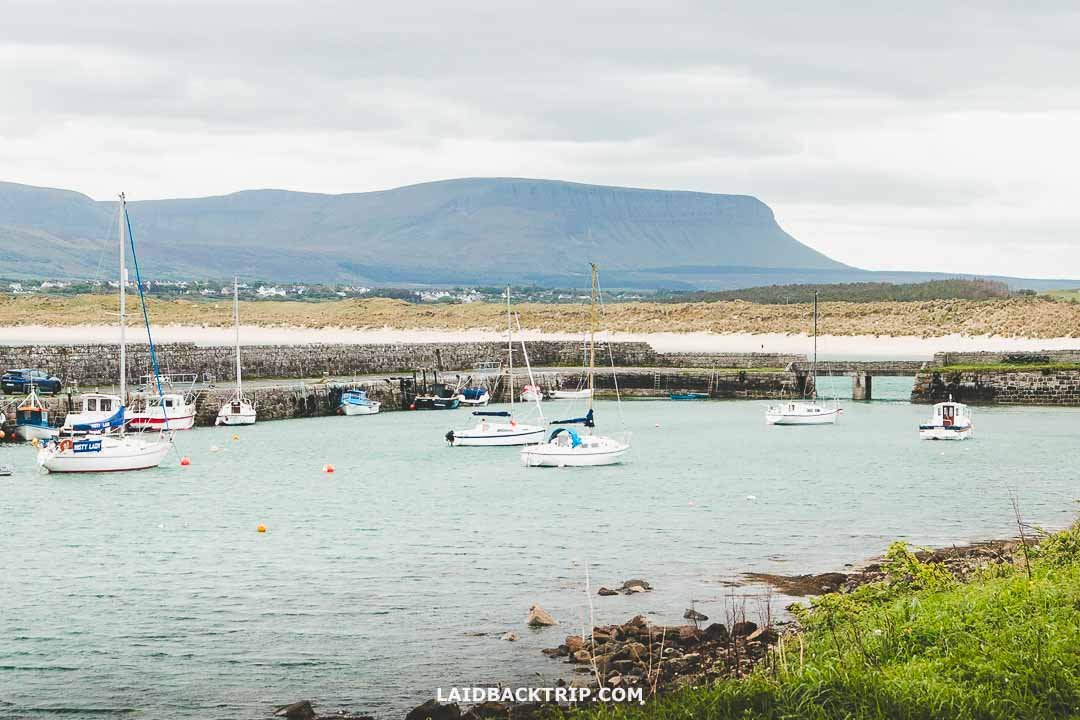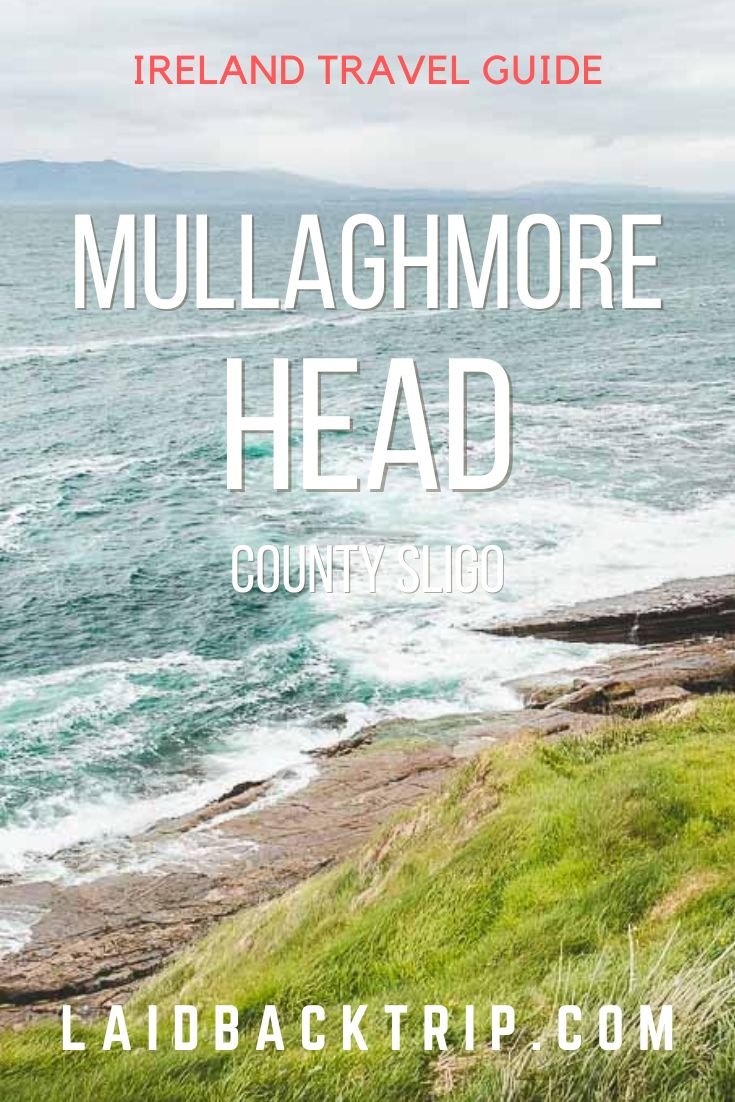How to Visit Mullaghmore Head
Read our travel guide on Mullaghmore Head in Ireland. Includes best things to do and see, tips on where to stay, how to get, or when to go.
If you can't get enough of Ireland's coastal destinations, consider including Mullaghmore Head in your Ireland itinerary.
It's located in County Sligo, near the border with County Leitrim, and is easily accessible by car.
Therefore, Mullaghmore, which means 'the great summit,' makes a great addition to your Wild Atlantic Way road trip.
This small but rugged peninsula is known for its stunning sandy beach, huge waves, water sports, and peaceful seaside village. And the uninterrupted views of the Atlantic Ocean.
If you're looking for a quiet break away from the crowds, Mullaghmore will not disappoint.
Best Things to Do on Mullaghmore Head
Unless you arrive here in summer, there are not that many things to see and do on Mullaghmore Head.
The ideal location and beautiful setting attract crowds during the peak season, especially those who enjoy water activities such as sailing, swimming, kitesurfing, sea-angling, or lazing on a beach.
In the off-season, enjoy the panoramic views and serene atmosphere Mullaghmore has to offer.
Mullaghmore Head
Mullaghmore Head is a curious case. Now, the next passage may sound a bit weird, but hear us out.
The cliffs at Mullaghmore Head are not as spectacular as in Slieve League, the breaking waves are dangerous, the only castle on the peninsula is inaccessible, and the golden beach is beautiful, but that can be said pretty much about every sandy strip in Ireland.
On top of that, it's very small, and the loop can be driven in less than 20 minutes.
Yet, Mullaghmore Head is a captivating place to visit.
It's the incredible setting with Benbulben in the backdrop that makes this peninsula so beautiful. From certain angles, Mullaghmore reminded us of our trip to Iceland we did a few years back.
And that's most likely the most convincing reason we can give you to visit this area in the off-season.
It's also incredibly easy to visit, and due to its small size, you don't need that much time to see it all.
Thanks to its amazing beach, summer turns Mullaghmore into a proper holiday destination, while the rest of the year offers a relaxing experience.
However, our favorite part of Mullaghmore was the northwestern part of the peninsula, which has rugged cliffs and can be explored along a quiet rural road.
Mullaghmore Beach
A sheltered bay is home to a stunning 2-kilometer stretch of golden sand known as Mullaghmore Beach.
Thanks to Benbulen in the backdrop, we have to admit that Mullaghmore Beach is also incredibly beautiful when seen from afar.
The beach was almost empty when we were there, but we had a feeling it gets busy during the summertime, especially on weekends.
On the other hand, it was not surprising as the weather was really cold and windy.
By the time we reached Mullaghmore, the rain had started to pour down, and we had to retreat to our car.
Unlike Inch Beach or Ballinskelligs, we didn't really get a chance to see what the beach was about.
Mullaghmore Beach is easily accessible from Mullaghmore town, where you will also find free parking.
In general, it's safe to swim at Mullaghmore Beach, and there are even safeguards from June to September.
However, you should check the official Sligo County Council website before you go.
The beach had been closed in the past due to water quality issues.
Either way, it's worth seeing, even if it's just for a walk.
The views are really stunning, and there is no entry fee, so it's a great place to visit when visiting Ireland on a budget.
Mullaghmore Village
Situated on the peninsula's eastern side, Mullaghmore is a typical Irish seaside village, one of many you can see on your trip along Wild Atlantic Way.
It's sheltered from the Atlantic Ocean, has a small population, and is very quiet troughout the year.
However, this is a popular summer holiday destination, so it becomes quite lively during this period.
Mullaghmore has a picturesque stone harbor, very limited accommodation options, and a couple of restaurants.
In case you're interested in monastic history, you can take a boat trip from Mullaghmore to Inishmurray.
This small island lies west of the village and has a 6th-century settlement founded by St. Molaise, a few restored beehive structures, and derelict 19th-century houses.
The residents are long gone, and only a few tourists come here to visit this place, now only occupied by sea birds.
Classiebawn Castle
Even though it's closed to the public, Classiebawn Castle is a must-see attraction on Mullaghmore Head.
It was built on a 10,000-acre estate for the third Viscount Palmerston in the 19th century, and its interesting architecture has been in stark contrast with the striking scenery of Mullaghmore Head ever since.
Thanks to the surrounding natural beauty, Classiebawn is one of the most charming castles in Ireland.
Classiebawn Castle has a long and rich history, like so many similar manor houses.
The history of this castle is among the most interesting ones, as it includes the confiscation of property, the assassination of Lord Mountbatten, and even a link to the Royal Family.
Speaking of which, Classiebawn Castle was featured on Netflix's popular show The Crown.
Unfortunately, the castle is pretty far from the main road, and you will need a good telephoto lens or binoculars to get the best view of the castle.
If you're looking for a proper castle experience, you must look elsewhere. Kilkenny Castle or Rock of Cashel were among our favorite castles in Ireland.
Surfing
If you're a fan of adrenaline sports, then you should know that Mullaghmore is a big wave surfing destination.
And by big waves, we mean big.
In the past, up to 20-meter waves were recorded here, and some of these giants were ridden by the most fearless surfers in the world.
In fact, Mullaghmore is getting more and more popular each year, slowly becoming one of the best big wave surf spots in the world.
Winter swells an unforgettable spectacle as these giant and dangerous waves can be ridden only by elite surfers.
By the way, only 15 kilometers east of Mullaghmore lies Bundoran, known as Ireland's surf capital.
As you will find a great variety of waves for all levels and abilities, Bundoran is often considered among the best surfing places in Ireland.
Mullaghmore Head Walk
Due to Mullaghmore's compact size, this peninsula can also be explored on foot.
In fact, the 5-kilometer Mullaghmore Head Walk is often mentioned among the best easy walks in Sligo.
Although this might sound like fun, and we can't deny the views are stunning, we are still not really sure about it.
While the Mullaghmore Head is not the most heavily trafficked place in Ireland, a big part of the trail leads along its main road.
There are far better hikes in Ireland without the need to watch out for oncoming traffic.
Diamond Hill in Connemara or Spinc Loop in the Wicklow Mountains are the first trails that come to our minds.
Here in Mullaghmore, we would prefer to take a stroll along the stunning beach instead.
Or head out to nearby Gleniff Horseshoe Trail, which offers dramatic views of the Dartry Mountains.
By the way, don't confuse this walk with Mullaghmore Loop Walk in Burren National Park, which is another great hike in Ireland.
How Much Time Do I Need
Even though it's relatively small, Mullaghmore Head has plenty of areas to stop and enjoy the stunning views of the coast and the Atlantic Ocean.
In principle, you should be able to drive around Mullaghmore Head in less than 30 minutes, including a few photo stops along the way.
But of course, that depends on the season and how much time you spend at each place.
So it comes without surprise when we say how much time you spend on Mullaghmore Head really depends on you.
We are sure some will be able to see everything in an hour or two while others can easily spend a whole day sitting on the beach and enjoying the sun.
Regardless of the season, the best time of the day to visit Mullaghmore Head is early in the morning or late in the afternoon.
As usual, sunset or sunrise from the beach will provide an incredible experience for everyone.
When to Go
As this is a coastal area, summer is definitely the best time to visit Mullaghmore Head.
At least if you want to spend some time on the beach, swim in the sea, or try water sports.
Not surprisingly, summer is the most popular when to visit Ireland in general.
We visited Mullaghmore Head in spring, and while the scenery was beautiful, it was pretty windy and cold there.
The beach was empty, and the cold waters of the Atlantic Ocean were not really inviting.
Winter is a great time to visit Mullaghmore if you prefer solitude and no crowds.
Keep in mind that some businesses close down during the off-season.
What to Pack
In summer, sunglasses, sunscreen, a bathing suit, comfortable walking shoes, and a water bottle are all packing essentials you need.
On top of that, a light windbreaker or rain jacket will come in handy not just on Mullaghmore Peninsula but pretty much in every destination.
Here you will find our full Ireland packing list.
How to Get There
Even though a local bus operated by TFI Local Link goes to Mullaghmore village from Sligo, we believe the best way to get there is by car.
It allows you to drive around Mullaghmore Peninsula at your own pace and stop as many times as you want along the way.
Narrow roads are one of the reasons why driving in Ireland is not that easy.
And while the R279, which connects Mullaghmore with N15, has two lanes, the rural road that encircles the peninsula's northern part is quite narrow.
Drive carefully and allow extra time for your journey so you don't need to rush.
Also, don't forget to read our guide on renting a car in Ireland.
Travel Resources
When renting a car, we use Rentalcars.com.
Directions
To get here, follow the N15 north from Sligo to Cliffony for 20 kilometers. Here turn left onto R279, which will bring you to Mullaghmore.
From Donegal, follow N15 for 40 kilometers and then turn right onto R279.
Getting to Mullaghmore from Dublin takes about three hours via M4 and N4.
The most direct route from Galway takes about two and a half hours.
However, we recommend following the scenic coastal route instead, as it features some amazing places such as Connemara National Park, Wild Nephin National Park, or Knocknarea.
Parking
Whether you go to Portmagee, Kinsale, or Mullaghmore, finding an empty parking space is usually quite an adventure.
Luckily, there is a fairly large parking area along Mullaghmore's waterfront.
It's free and has plenty of parking spaces available for visitors coming to this area.
Where to Stay
There is limited accommodation at Mullaghmore Head, but it's close to Sligo town itself, which offers plenty of options.
Even though this is a small-sized town, it has everything you need during your stay. There are many options within driving distance in the area, especially along the coast.
Here you will find everything from small family-owned bed and breakfasts to hotel resorts.
They often offer good deals, but you need to book early as they usually have only a few rooms.
Here are our tips on the best hotels at Mullaghmore Head and its surrounding.
Mullaghmore | Pier Head Hotel - Situated on Mullaghmore Head, this hotel has an ideal location, cozy rooms with sea views, an indoor swimming pool, and free private parking.
Bundoran | Allingham Arms Hotel - Located a 10-minute drive from Mullaghmore Head, this hotel features clean rooms with a sea view, tasty breakfast, and welcoming staff. Free parking is available.
Sligo | Riverside Hotel - Situated in Sligo's center, this hotel has affordable rooms with river views, a great restaurant, and a superb location close to everything.
Staying Safe
In principle, Mullaghmore Head is a very safe place to visit.
If you decide to swim in the sea, consider your abilities and the current conditions.
Also, make sure to stay visible when walking on the road that goes around the peninsula.
Here you will find more tips on staying safe in Ireland.
Travel Insurance
We never leave home without travel insurance that was designed to cover our expenses if something goes wrong during the trip.
Travel insurance protects against theft, flight delays, injury, illness, cancellations, and much more.
World Nomads provides travel insurance for travelers to cover their trip essentials, including sports and adventure activities.
SafetyWing is affordable travel insurance for backpackers, long-term travelers, and digital nomads.
Travel smarter and safer!
Is Mullaghmore Head Worth Visiting?
If your trip along the Wild Atlantic Way brings you to County Sligo, Mullaghmore Head is worth seeing.
Thanks to its amazing beach and beautiful surrounding scenery, it's a popular holiday destination for locals during the summer.
Pleasant temperatures, good swimming conditions, water sports, and rugged landscape are some of the biggest draws of Mullaghmore.
However, it's a great addition to every Ireland road trip, even if you visit during the low season when the crowds are gone.
Travel Resources
Here you can find links to all the travel resources we use and which you might find helpful when planning your next holiday.
Accommodation: When looking for accommodation, we usually search hotels via Booking.com or Hostelworld.
Tours: Although we love to travel independently, some places are better to visit with a guided tour.
We prefer GetYourGuide for its easy-to-use interface and solid reputation. Another great alternative is Viator.
Rental Cars: When going on a road trip, we always use Rentalcars.com, a reliable site for booking a rental car in advance.
Flight Tickets: When looking for flight tickets, you can search Skyscanner to find the best price.
Travel Insurance: World Nomads and SafetyWing cover against risks of travel.












